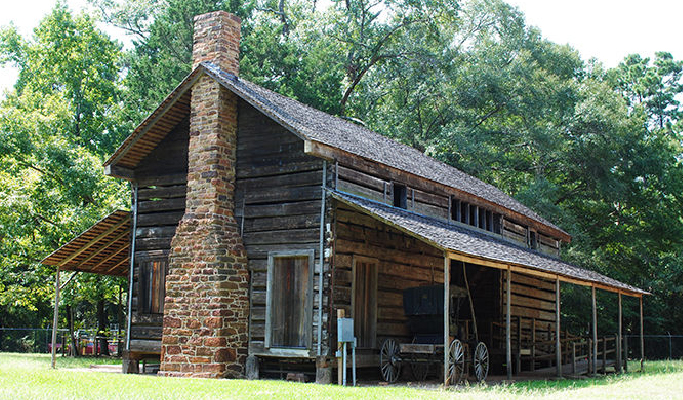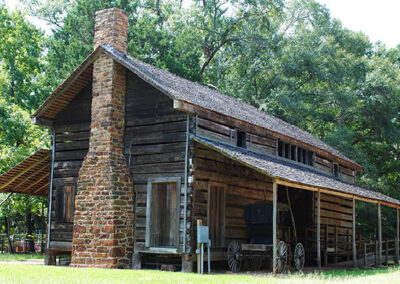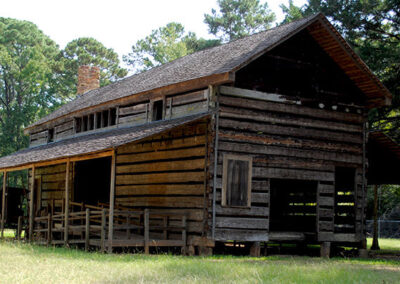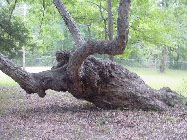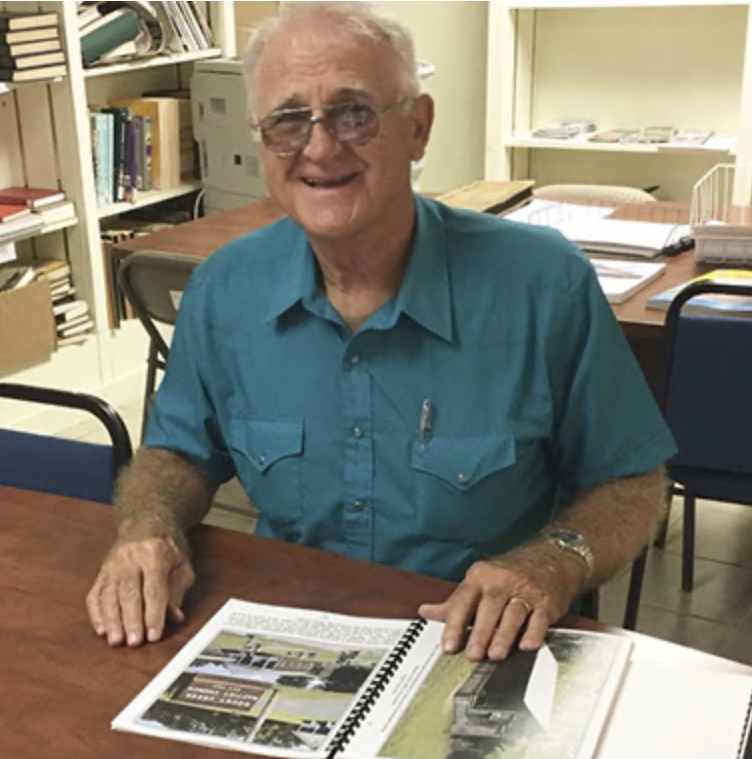
American structure that exists in Texas today. It was built about 1818 by James D. Taylor Gaines who was a double first cousin to General Edward Pendleton Gaines of the United States Army. [1. The Men Who Made Texas Free by Sam Houston Dixon-Copyright 1924-Texas Historical Publishing Company Houston, Texas] A few historians and descendants say that he was a brother to General Gaines. [2. The Handbook of Texas Online – Copyright 2002 -The Texas State Historical Association] The house was built for his third wife’s parents, the Edmund Norris’, so that they could live in the vicinity of the settlement that had become established around the ferry on the Sabine River. In the 1835 Sabine District Census, James is listed as head of the household at age 53 along with his wife Susannah Norris Gaines at age 36 and children John age 17, James age 8, Sarah Ann age 4 and William age 5 months. [3. 1835 Sabine District Census by Helen Gomer Schluter-Copyright 1983-Ericson Books Nacogdoches, Texas]
Although listed in the 1835 census as being 53 years old, James was born in Culpepper County, Virginia on 14 Nov 1776, the son of Thomas and Susannah Strother Gaines. The Gaines family was considered as one of the oldest and best known in Virginia. He was christened Robert Thomas Gaines, but around 1810 changed his name to James. He first married Isabella Christian of Tennessee and they had one daughter. A second marriage to Katherine Vincent of Indiana produced two sons. The third marriage to Susannah Norris of the Nacogdoches Municipality produced six children, four of whom are listed in the 1835 census. [4. A Compilation of Gaines Family Data by Calvin E. Sutherd-Copyright 1969-Fort Lauderdale, Florida] James was described as being tall, red-haired and red-faced.
In late 1803 and most of 1804 James accompanied then Lieutenant Edward Pendleton Gaines on an assignment ordered by President Thomas Jefferson to survey the waterways along the Natchez Trace, from Nashville, Tennessee down the Cumberland River to the Ohio, and on to New Orleans.[5. National Archive-Waterway Survey Records Washington, D.C.] When the United States troops were established at Natchitoches, Louisiana in 1805, James accompanied them and started a mercantile business in Natchitoches. By 1812 he was operating a ferry on the Sabine River, although some historians say he was at the crossing as early as 1809. The 1812 date was given by James Gaines in open court testimony while testifying in a land grant trial involving two of his former neighbors. [6. The Crocket Collection Stephen F. Austin State University Library Nacogdoches, Texas] His testimony in the 1843 trial of the RUSSELL HEIRS Vs. JAMES MASON clearly establishes the 1812 date. During the Gutierrez-Magee Expedition, he raised and commanded troops in an effort to wrest Texas from Spanish Mexico. After their defeat in San Antonio, he went to Virginia and fought against the British during the War of 1812. James also participated in the Fredonia Rebellion, was with Dr. Long’s Expedition, His testimony in the 1843 trial of the RUSSELL HEIRS Vs. JAMES MASON clearly establishes the 1812 date. During the Gutierrez-Magee Expedition, he raised and commanded troops in an effort to wrest Texas from Spanish Mexico. After their defeat in San Antonio, he went to Virginia and fought against the British during the War of 1812. James also participated in the Fredonia Rebellion, was with Dr. Long’s Expedition,[7. Citizen-Soldiers of Sabine County, Texas (1812-1991) by Robert Cecil McDaniel Copyright 1992 Texian Press Waco, Texas] delegate to the Washington-on-the Brazos Convention-1 Mar 1836, signer of the Texas Declaration of Independence, helped draft the Republic of Texas constitution, served as senator in the Fourth, Fifth and Sixth Congress representing Harrison, Sabine and Shelby Counties, served as sheriff and alcalde (judge) for the Sabine District of the Municipality of Nacogdoches, served as postmaster, operated an inn and mercantile store, forwarded mail across the boundary into the United States and founded the settlement of Pendleton.[8. The Handbook of Texas Online The Texas State Historical Association-Copyright 2002] In July of 1819 while serving with Dr. Long, James delivered a letter to Jeanne Lafitte in Galveston and discussed with Lafitte the plans to take Texas from Spanish Mexico.[9. Romance and Tragedy of Texas History by Sam Houston Dixon Copyright 1924 Texas Historical Publishing Company Houston, Texas]
In about 1819, James bought the long established ferry on the El Camino Real that had been used as a crossing as early as 1541-1542 by Hernando De Soto, who had advanced to Nacogdoches and earlier by Native Americans. From the late 1600’s through the 1840’s, this crossing on the Sabine River was being used by Indians, early explorers, traders, kantucks, adventurers, missionaries, desperados, post riders, smugglers, empresarios, filibusters, settlers, slaves, circuit riders and preachers, soldiers and statesmen. During the twenty years that James owned the ferry; historians say that at least four-fifths of the settlers coming into Texas crossed on this ferry. The number is estimated to be fifty thousand or more. Most of the patriots, involved in the struggle with Mexico for independence, crossed at this site and passed within two hundred feet of the Gaines-Oliphint House. In 1843 James sold his ferry and moved to Nacogdoches and became involved in the movement to have Texas annexed into the United States.[10. Inventory of the County Archives of Texas by The Historical Records Survey-Division of Professional and Service Projects-Works Progress Administration-June 1939-San Antonio, Texas]
In the mid-1840s James moved to Bastrop in Central Texas, where he bought and operated a hotel. When news spread in 1849 about the gold rush in California, two of James’s sons, Edmund and John B. along other East Texans, headed west. On 23 Aug 1850 James arrived in San Francisco on the steamer Ecuador. He and his sons discovered the Gaines Ledge of gold and established the Gaines Mine that still exists today. He served in local Mariposa County, California government for several years. By 1854-1855 Susannah had died, and his two sons had returned to Texas. On 12 Nov 1856, two days before his eightieth birthday, James died in Oakland, California.[11. “Mt. Gaines: 135 Years of Mother Lode Mining” January-February 1985 by Carl Briggs, The Californian]
In about 1815 on a high knoll that was above flood stage and about three hundred yards from the ferry, James built his family a new home. The house was of log construction with an open hallway through the middle, often called by early settlers a double pen log house with a dog trot. There were two large rooms on the bottom floor with a large hand shaped native iron ore rock fireplace in the end of each room. In the hallway a stair case led to the second story which also had two large rooms. In 1967 this house was still standing. In 1959 the states of Louisiana and Texas formed the Sabine River Authority for the purpose of building a large reservoir along the boundary of the two states for flood control and power generation. By 1969 the Sabine River Authority had completed the Toledo Bend Reservoir Project that resulted in parts of both states being covered by the lake.[12. Sabine County, Texas-The First One Hundred and Fifty Years (1836-1986) by Robert Cecil McDaniel-Copyright 1987-The Texan Press Waco, Texas]
In late 1967, the old James Gaines House was dismantled, parts numbered and moved from its original location because the area was to be inundated by the reservoir. The intent at the time was for the house to be reassembled and become a historical attraction. On a location 2.2 miles southwest of the original location the disassembled house was stored and covered with old sheet metal and tarps. Over a period of years, because of lost interest in the restoration project, the disassembled structure totally decayed and was lost.
The house built by James Gaines for his third wife’s parents, the Edmund Norris’, referred to as the Gaines-Oliphint House was an exact copy of the old Gaines house. It was built between 1815-1818 about 0.6 miles west of the ferry location and sits at 263 feet elevation overlooking the Sabine River bottom. At this location the river bottom was only 0.2 of a mile wide on the Texas side and 2.0 miles wide on the Louisiana Side. The original road crossed at the ferry location and continued west and passed about two hundred feet in front of the Gaines-Oliphint House, then continues southwest, crossing Carrice Creek and on toward Milam. The house has hand shaped native iron ore rock fireplaces in both end of the house. The original fireplace in the east end of the house is still standing in good condition. The west end fireplace was taken down many years ago because it began leaning away from the house and was unsafe. After a twenty year effort to save the house, the front porch and its roof and the back porch were taken off because of decay and the threat of loosing the main structure. The unattached kitchen was moved back away from the main structure. A new sheet metal roof was placed on the main structure and over the porch locations which has kept the house in good condition. The beginning configuration of the kitchen is unknown but was probably entered through the door opening in the northeast corner and to the left of the fireplace.
Another very interesting and historical object on the property is an ancient white oak tree (Quercus alba) that is located about forty eight feet south of the southwest corner of the house. The original road passed about one hundred fifty feet south of the tree or two hundred feet from the house. The tree was at one time about fifty five inches in diameter. The ravages of time have rotted away most of the main trunk and only a partial shell remains. Several years ago the tree was blown down by a storm and now lies on the ground, but several very healthy limbs turned skyward and continue to grow today. Legend has it that while James was serving as sheriff and judge (alcalde) in the Pendelton settlement several hangings took place under this tree. During the early years of the settlement the shade of this tree is said to have provided a meeting place to discuss local issues involving the pre-republic, the Republic of Texas and statehood. The tree is estimated to be at least three hundred twenty five years old. Two other features on the grounds are a small double pen log barn that is in bad repair and of unknown age, and a cistern for the collection and storage of rain water.
In 1840 the house and sixty one acres of land were sold to Wilford R. Oliphint, but apparently the bargain seems to have fallen through. On 17 Feb 1843 James did sell the property to Martha A. Oliphint. Several of the owners cannot be traced because of a court house fire in 1875 that destroyed most Sabine County records. In 1975-1976 the house was placed on the National Register of Historic Places. After an effort made over several years, finally in June of 1984 the house and two acres of land were donated by Mrs. Tom Foster of Center, Texas for the purpose of historical restoration. Several groups have tried to raise funds for restoration, and in Fall 1999 this project was taken over by the Daughters of the Republic of Texas (DRT) James Frederick Gomer Chapter out of Hemphill, Texas when the Sons of the Republic of Texas (SRT) Sabine Chapter, gifted and deeded the property to the DRT chapter. Several fund raisers have been held since 1999. One of the largest fundraisers is Pioneer Days held the third Saturday in April.
Recent preservation projects finished by the James Frederick Gomer Chapter, DRT, as outlined by the Texas Historical Commission (THC) approved Master Plan include:
1. Stabilization of the house, especially after the damage suffered from Hurricanes Rita and Ike
2. Restoration of one of the chimneys
3. Restoration of the fireplace and mantle
4. Restoration of the board and batten in one of the rooms
Currently the chapter is accepting donations for the restoration of the home’s original cedar shingles. Donations can be sent c/o the James Frederick Gomer Chapter, DRT, at the address below. All donations are tax-deductible. Tours of the property are available by appointment only. Contact the Chapter President at the phone number below.
Bibliography
- A Compilation of Gaines Family Data by Calvin E. Sutherd Copyright 1969 rev. 1972 Fort Lauderdale, Florida
- Cemeteries of Sabine County, Texas-With Expanded Burial Index (1840-2004) by Weldon McDaniel Copyright 2004 Charcoal Hill Publishing Hemphill, Texas
- Citizen Soldiers of Sabine County, Texas (1812-1991) by Robert Cecil McDaniel Copyright 1992 Texian Press Waco, Texas
- The First Settlers of Sabine County, Texas by Gifford White Copyright 1983 Ericson Books Nacogdoches, Texas
- The Handbook of Texas Online Copyright 2002 The Texas Historical Association
- Historic Nacogdoches, Texas by R. B. Blake Copyright 1939 The Redland Herald Nacogdoches, Texas
- History and Tax Records of The Sabine District and Sabine County, Texas by The James Frederick Gomer Chapter of The Daughters of the Republic of Texas
- Inventory of the County Archives of Texas by The Historical Records Survey-Division of Professional and Service Projects-Works Progress Administration June 1939 San Antonio, Texas
- Lone Star-A History of Texas and the Texans by T. R. Fehrenbach Copyright 1968, 2002 Da Capo Press
- Lone Star Nation by H. W. Brands Copyright 2004 Doubleday New York, New York
- The Men Who Made Texas Free By Sam Houston Dixon Copyright 1924 Texas Historical Publishing Company Houston, Texas
- “Mt. Gaines: 135 Years of Mother Lode Mining” January-February 1985 by Carl Briggs, The Californian
- National Archives-Waterway Survey Records Washington, D. C.
- Old Timers of Sabine County, Texas by Virgie Speights Copyright 1983 Ericson Books Nacogdoches, Texas
- Romance and Tragedy of Texas History by Sam Houston Dixon Copyright 1924 Texas Historical Publishing Company Houston, Texas
- Sabine County Historical Sketches and Genealogical Records by Edna M. White and Blanche F. Toole Copyright 1972 LaBelle Printing Company Beaumont, Texas
- Sabine County, Texas-The First One Hundred and Fifty Years (1836-1986) by Robert Cecil McDaniel Copyright 1987 Texian Press Waco, Texas
- 1835 Sabine District Census by Helen Gomer Schluter Copyright 1983 Ericson Books Nacogdoches, Texas

